
A shrine to the Virgin Mary, or Marian shrine, is a shrine marking an apparition or other miracle ascribed to the Blessed Virgin Mary, or a site on which is centered a historically strong Marian devotion. Such locales are often the destinations of Christian pilgrimages.
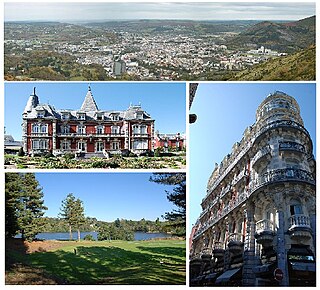
Lourdes is a market town situated in the Pyrenees. It is part of the Hautes-Pyrénées department in the Occitanie region in southwestern France. Prior to the mid-19th century, the town was best known for its Château fort, a fortified castle that rises up from a rocky escarpment at its center.
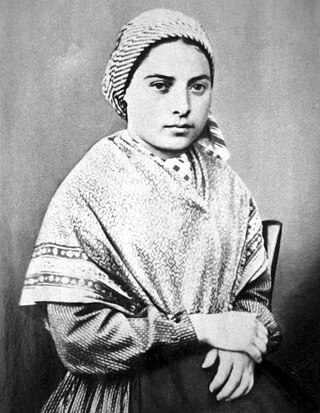
Bernadette Soubirous, also known as Bernadette of Lourdes, was the firstborn daughter of a miller from Lourdes, in the department of Hautes-Pyrénées in France, and is best known for experiencing apparitions of a "young lady" who asked for a chapel to be built at the nearby cave-grotto. These apparitions occurred between 11 February and 16 July 1858, and the woman who appeared to her identified herself as the "Immaculate Conception".

The Sanctuary of Our Lady of Lourdes is a Catholic Marian shrine and pilgrimage site dedicated to Our Lady of Lourdes in the town of Lourdes, Hautes-Pyrénées, France. The sanctuary includes several religious buildings and monuments around the grotto of Massabielle, the place where the events of the Lourdes apparitions occurred in 1858, among them three basilicas, the Basilica of Our Lady of the Immaculate Conception, the Rosary Basilica and the Basilica of St. Pius X, respectively known as the upper, lower and underground basilica.

Żurrieq is a town in the Southern Region of Malta. It is one of the oldest towns in the country, and it has a population of 11,823 inhabitants as of March 2014. Żurrieq is one of the 10 parishes to be documented in 1436 and it is dedicated to Saint Catherine. The island of Filfla is administratively a part of the town. The town stretches from Nigret to Ħal Far. In old times the town was had a border with Żejtun. The village of Qrendi used to be part of the parish of Żurrieq until 1618 when it was made into its own parish.

Carfin Lourdes Grotto, a Roman Catholic shrine in Scotland dedicated to Our Lady of Lourdes, was created in the early twentieth century. The "Carfin Grotto", as the shrine is locally referred to, was the brainchild of Father, later Canon Thomas N. Taylor, parish priest of St. Francis Xavier's Parish in the small, mining village of Carfin, which lies two miles east of Motherwell, in the West of Scotland. Following a trip to France's principal Marian shrine at Lourdes, Canon Taylor's vision was to build a religious memorial in honour of Our Blessed Lady based on the template of the Grotto of Massabielle. To realize this vision became his life's work. Since its opening in the early 1920s, the "grotto" has attracted pilgrims in the hundreds of thousands and its environs have been modified and enhanced with rich Catholic symbols and buildings. The grotto shrine offers a pilgrimage season with Sunday processions, rosaries, outdoor Masses and dedicated Feast Day events which run annually from early May until late September.

Qrendi is a village in the Southern Region of Malta, with a population of 3148 people as of October 2021. It is located close to Mqabba, Żurrieq and Siggiewi. Within its boundaries are two well-known Neolithic temples called Mnajdra and Ħaġar Qim. In this village two feasts are held annually. The feast of Our Lady of Lourdes is celebrated either on the last Sunday of June or on the first Sunday of July, with 15 August the titular feast of the Ascension of Our Lady. This feast is popularly known as the feast of Santa Maria.
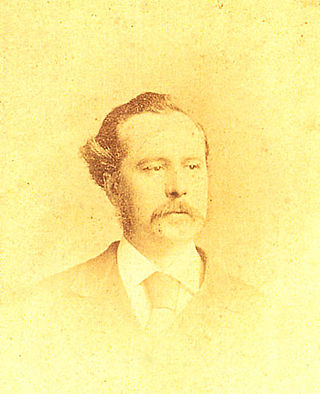
Edward Welby Pugin was an English architect, the eldest son of architect Augustus Welby Northmore Pugin and Louisa Barton and part of the Pugin & Pugin family of church architects. His father was an architect and designer of Neo-Gothic architecture, and after his death in 1852 Edward took up his successful practice. At the time of his own early death in 1875, Pugin had designed and completed more than one hundred Catholic churches.
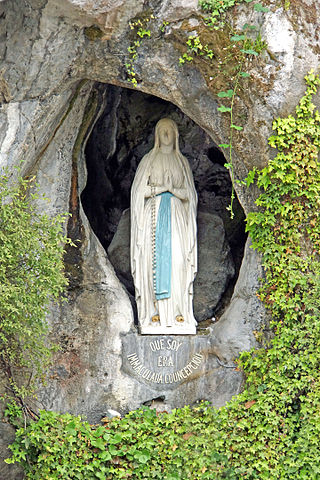
Our Lady of Lourdes is a title of the Virgin Mary. She is venerated under this title by the Roman Catholic Church due to her apparitions that occurred in Lourdes, France. The first apparition of 11 February 1858, of which Bernadette Soubirous told her mother that a "Lady" spoke to her in the cave of Massabielle while she was gathering firewood with her sister and a friend. Similar apparitions of the "Lady" were reported on 18 occasions that year, until the climax revelation in which she introduced herself as: "I am the Immaculate Conception". On 18 January 1862, the local Bishop of Tarbes Bertrand-Sévère Laurence endorsed the veneration of the Blessed Virgin Mary in Lourdes.

Ballinkillin or Ballinkillen is a small village between Borris and Bagenalstown in County Carlow, Ireland. The village itself has 20 homes and about 74 people. It includes a national school, shop, hurling pitch and two housing estates.

Abbé Dominique Peyramale was a Catholic priest in the town of Lourdes in France during the apparitions of Our Lady of Lourdes to the peasant girl Bernadette Soubirous in 1858. According to Bernadette, her visions occurred at the grotto of Massabielle, just outside Lourdes.

The Basilica of Our Lady of the Rosary is a Roman Catholic church and minor basilica within the Sanctuary of Our Lady of Lourdes in France. Its main theme is a celebration and depiction of the Rosary.

St. Werburgh's Church is a Church of Ireland church building in Dublin, Ireland. The original church on this site was built in 1178, shortly after the arrival of the Anglo-Normans in the town. It was named after St. Werburgh, abbess of Ely and patron saint of Chester. The current building was constructed in 1719. It is located in Werburgh Street, close to Dublin Castle.
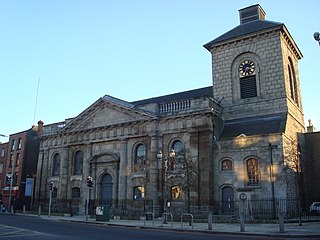
St. Catherine's Church, on Thomas Street, in Dublin, Ireland, was originally built in 1185. It is located on what was once termed the "Slí Mhór", a key route that ran westwards across Ireland from Dublin. The church was rebuilt in its present form in the 18th century by John Smyth.

The Assumption of the Blessed Virgin Mary Church is a Catholic church of the Archdiocese of Detroit located at 13770 Gratiot Avenue in Detroit, Michigan. It is commonly known as the Assumption Grotto Church. The church community was founded in the 1830s, and the present building completed in 1929, designated a Michigan State Historic Site in 1990 and listed on the National Register of Historic Places in 1991.

Kildare Cathedral, or St Brigid's Cathedral in Kildare, is one of two Church of Ireland cathedrals in the United Dioceses of Meath and Kildare. It is in the ecclesiastical province of Dublin. Originally a Catholic cathedral, it was built in the 13th century on the site of an important Celtic Christian abbey, which is said to have been founded by Saint Brigid in the 5th century. The site was taken over by the Protestant Church of Ireland following the Reformation. There is an Irish round tower in the cathedral grounds.

The Church of St Nicholas of Myra (Without) is a Roman Catholic church on Francis Street, Dublin that is still in use today. The site has been used as a place of worship as far back as the 12th century. The current church was built in 1829 and dedicated to Saint Nicholas in 1835.
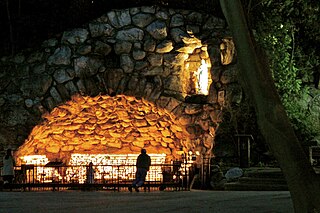
The Grotto of Our Lady of Lourdes is located at the University of Notre Dame in Notre Dame, Indiana, United States, and is a reproduction of the Grotto of Our Lady of Lourdes in Lourdes, France. The current Grotto was built in 1896, replacing a wooden grotto built on August 22, 1878. An artificial rock cave, the Grotto is used by its visitors as a sacred space for prayer, meditation, and outdoor Mass.

St. Mary's Church is a Grade B-1 listed Catholic church located in Chapel Lane/Smithfield area of Belfast, Northern Ireland. A church was opened on this site in May 1784 and thus it is the mother church for the city of Belfast. At the time, it was the only Catholic church in the then town of Belfast after the relaxation of some of the Penal Laws. The church grounds contain an undistinguished grotto dedicated to Our Lady of Lourdes. Until 2022 St. Mary's was a mensal parish of the Diocese of Down and Connor.
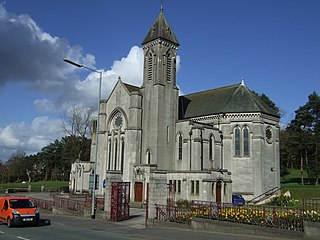
Our Lady of Lourdes Church is the Roman Catholic church of Hednesford in Cannock Chase, Staffordshire, England. A Grade II listed building, it was built in 1928–34 together with a Lourdes grotto and is a pilgrimage church.
























